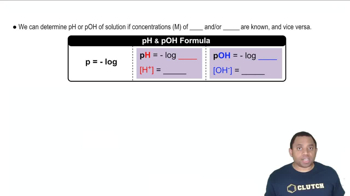Textbook Question
A 0.867-g sample of an unknown acid requires 32.2 mL of a 0.182 M barium hydroxide solution for neutralization. Assuming the acid is diprotic, calculate the molar mass of the acid.
 Verified step by step guidance
Verified step by step guidance


A 0.867-g sample of an unknown acid requires 32.2 mL of a 0.182 M barium hydroxide solution for neutralization. Assuming the acid is diprotic, calculate the molar mass of the acid.
A 25.0-mL volume of a sodium hydroxide solution requires 19.6 mL of a 0.189 M hydrochloric acid for neutralization. A 10.0-mL volume of a phosphoric acid solution requires 34.9 mL of the sodium hydroxide solution for complete neutralization. Calculate the concentration of the phosphoric acid solution.
What should the molar concentrations of benzoic acid and sodium benzoate be in a solution that is buffered at a pH of 4.55 and has a freezing point of -2.0 °C? (Assume complete dissociation of sodium benzoate and a density of 1.01 g/mL for the solution.)